Yubo Wan
Multi-User Pilot Pattern Optimization for Channel Extrapolation in 5G NR Systems
Jul 15, 2024
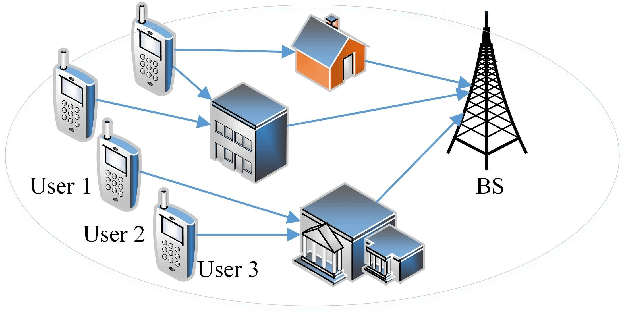
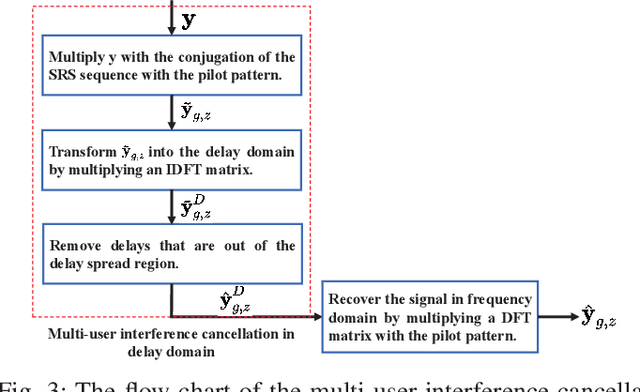
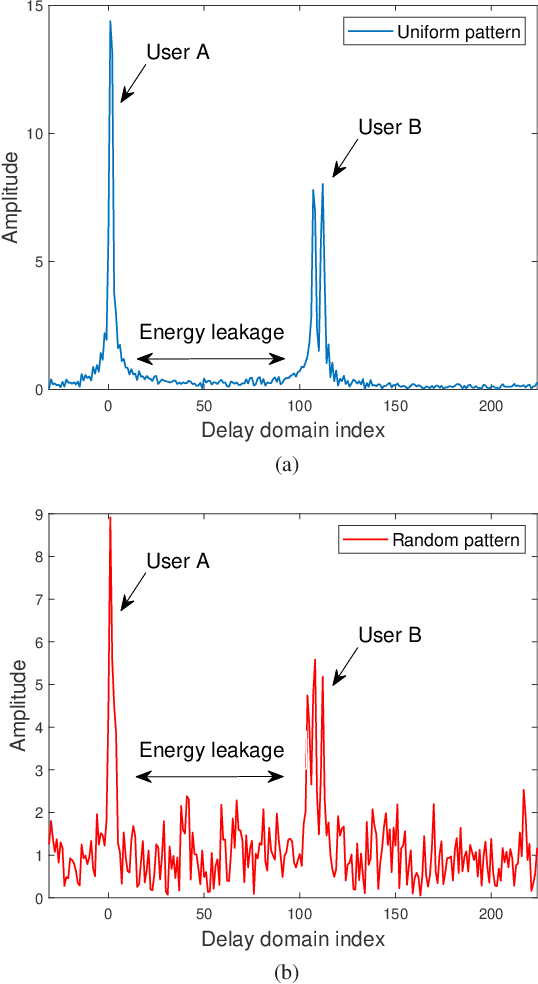
Abstract:Pilot pattern optimization in orthogonal frequency division multiplexing (OFDM) systems has been widely investigated due to its positive impact on channel estimation. In this paper, we consider the problem of multi-user pilot pattern optimization for OFDM systems. In particular, the goal is to enhance channel extrapolation performance for 5G NR systems by optimizing multi-user pilot patterns in frequency-domain. We formulate a novel pilot pattern optimization problem with the objective of minimizing the maximum integrated side-lobe level (ISL) among all users, subject to a statistical resolution limit (SRL) constraint. Unlike existing literature that only utilizes ISL for controlling side-lobe levels of the ambiguity function, we also leverage ISL to mitigate multi-user interference in code-domain multiplexing. Additionally, the introduced SRL constraint ensures sufficient delay resolution of the system to resolve multipath, thereby improving channel extrapolation performance. Then, we employ the estimation of distribution algorithm (EDA) to solve the formulated problem in an offline manner. Finally, we extend the formulated multi-user pilot pattern optimization problem to a multiband scenario, in which multiband gains can be exploited to improve system delay resolution. Simulation results demonstrate that the optimized pilot pattern yields significant performance gains in channel extrapolation over the conventional pilot patterns.
A Two-Stage 2D Channel Extrapolation Scheme for TDD 5G NR Systems
Oct 13, 2023



Abstract:Recently, channel extrapolation has been widely investigated in frequency division duplex (FDD) massive MIMO systems. However, in time division duplex (TDD) fifth generation (5G) new radio (NR) systems, the channel extrapolation problem also arises due to the hopping uplink pilot pattern, which has not been fully researched yet. This paper addresses this gap by formulating a channel extrapolation problem in TDD massive MIMO-OFDM systems for 5G NR, incorporating imperfection factors. A novel two-stage two-dimensional (2D) channel extrapolation scheme in both frequency and time domain is proposed, designed to mitigate the negative effects of imperfection factors and ensure high-accuracy channel estimation. Specifically, in the channel estimation stage, we propose a novel multi-band and multi-timeslot based high-resolution parameter estimation algorithm to achieve 2D channel extrapolation in the presence of imperfection factors. Then, to avoid repeated multi-timeslot based channel estimation, a channel tracking stage is designed during the subsequent time instants, in which a sparse Markov channel model is formulated to capture the dynamic sparsity of massive MIMO-OFDM channels under the influence of imperfection factors. Next, an expectation-maximization (EM) based compressive channel tracking algorithm is designed to jointly estimate unknown imperfection and channel parameters by exploiting the high-resolution prior information of the delay/angle parameters from the previous timeslots. Simulation results underscore the superior performance of our proposed channel extrapolation scheme over baselines.
Stochastic Particle-Based Variational Bayesian Inference for Multi-band Radar Sensing
Jul 21, 2022
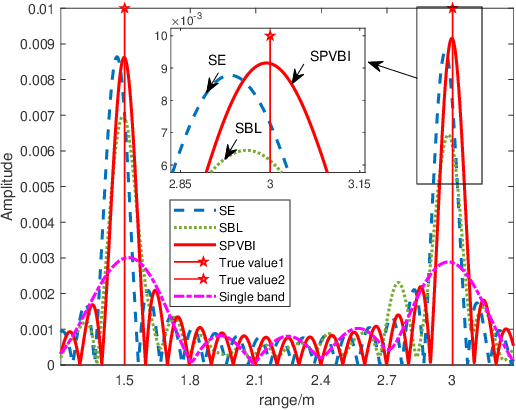
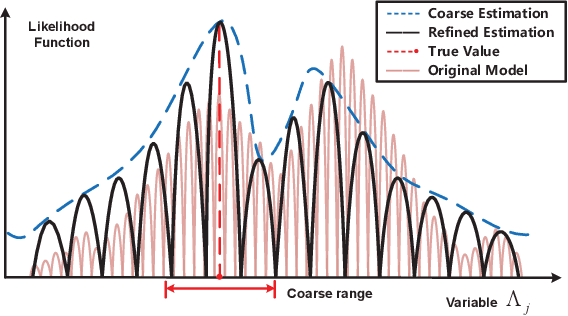
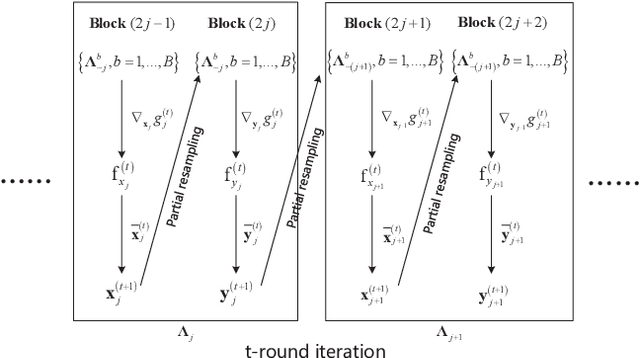
Abstract:Multi-band fusion is an important technology to improve the radar sensing performance. In the multi-band radar sensing signal model, the associated likelihood function has oscillation phenomenon, which makes it difficult to obtain high-accuracy parameter estimation. To cope with this challenge, we divide the radar target parameter estimation into two stages of coarse estimation and refined estimation, where the coarse estimation is used to narrow down the search range for the refined estimation, and the refined estimation is based on the Bayesian approach to avoid the convergence to a bad local optimum of the likelihood function. Specifically, in the coarse estimation stage, we employ a root MUSIC algorithm to achieve initial estimation. Then, we apply the block stochastic successive convex approximation (SSCA) approach to derive a novel stochastic particle-based variational Bayesian inference (SPVBI) algorithm for the Bayesian estimation of the radar target parameters in the refined stage. Unlike the conventional particle-based VBI (PVBI) in which only the probability of each particle is optimized and the per-iteration computational complexity increases exponentially with the number of particles, the proposed SPVBI optimizes both the position and probability of each particle, and it adopts the block SSCA to significantly improve the sampling efficiency by averaging over iterations. As such, it is shown that the proposed SPVBI can achieve a better performance than the conventional PVBI with a much smaller number of particles and per-iteration complexity. Finally, extensive simulations verify the advantage of the proposed algorithm over various baseline algorithms.
Fundamental Limits and Optimization of Multiband Sensing
Jul 21, 2022
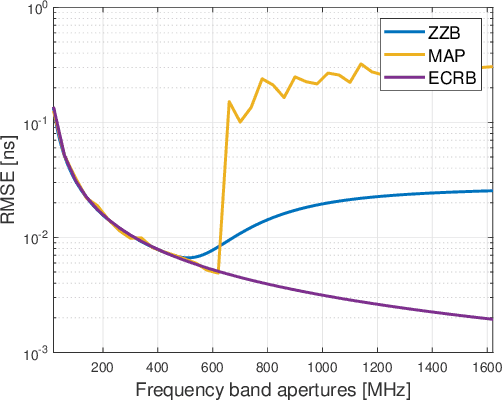
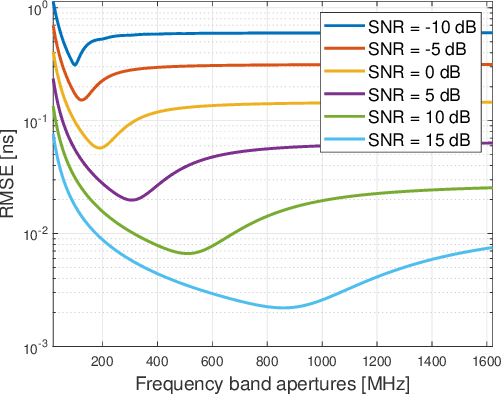
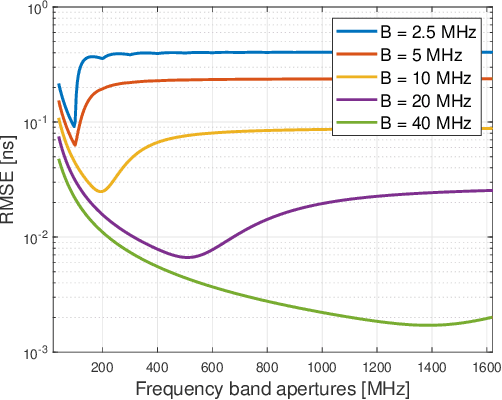
Abstract:Multiband sensing is a promising technology that utilizes multiple non-contiguous frequency bands to achieve high-resolution target sensing. In this paper, we investigate the fundamental limits and optimization of multiband sensing, focusing on the fundamental limits associated with time delay. We first derive a Fisher information matrix (FIM) with a compact form using the Dirichlet kernel and then derive a closed-form expression of the Cramer-Rao bound (CRB) for the delay separation in a simplified case to reveal useful insights. Then, a metric called the statistical resolution limit (SRL) that provides a resolution limit is employed to investigate the fundamental limits of delay resolution. The fundamental limits of delay estimation are also investigated based on the CRB and Ziv-Zakai bound (ZZB). Based on the above derived fundamental limits, numerical results are presented to analyze the effect of frequency band apertures and phase distortions on the performance limits of the multiband sensing systems. We formulate an optimization problem to find the optimal system configuration in multiband sensing systems with the objective of minimizing the delay SRL. To solve this non-convex constrained problem, we propose an efficient alternating optimization (AO) algorithm which iteratively optimizes the variables using successive convex approximation (SCA) and one-dimensional search. Simulation results demonstrate the effectiveness of the proposed algorithm.
Multiband Delay Estimation for Localization Using a Two-Stage Global Estimation Scheme
Jun 20, 2022


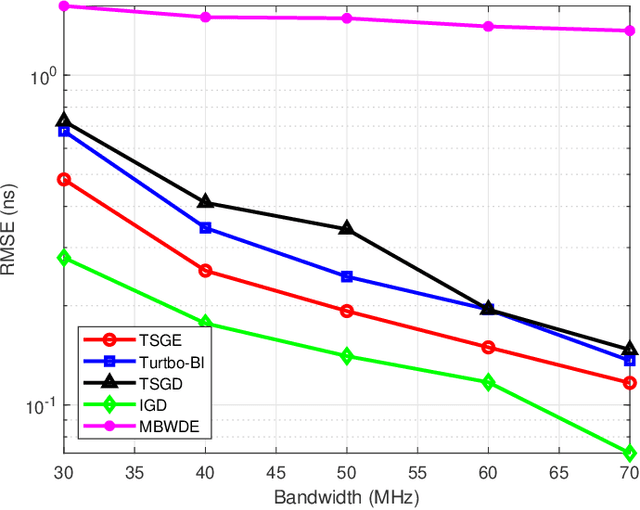
Abstract:The time of arrival (TOA)-based localization techniques, which need to estimate the delay of the line-of-sight (LoS) path, have been widely employed in location-aware networks. To achieve a high-accuracy delay estimation, a number of multiband-based algorithms have been proposed recently, which exploit the channel state information (CSI) measurements over multiple non-contiguous frequency bands. However, to the best of our knowledge, there still lacks an efficient scheme that fully exploits the multiband gains when the phase distortion factors caused by hardware imperfections are considered, due to that the associated multi-parameter estimation problem contains many local optimums and the existing algorithms can easily get stuck in a "bad" local optimum. To address these issues, we propose a novel two-stage global estimation (TSGE) scheme for multiband delay estimation. In the coarse stage, we exploit the group sparsity structure of the multiband channel and propose a Turbo Bayesian inference (Turbo-BI) algorithm to achieve a good initial delay estimation based on a coarse signal model, which is transformed from the original multiband signal model by absorbing the carrier frequency terms. The estimation problem derived from the coarse signal model contains less local optimums and thus a more stable estimation can be achieved than directly using the original signal model. Then in the refined stage, with the help of coarse estimation results to narrow down the search range, we perform a global delay estimation using a particle swarm optimization-least square (PSO-LS) algorithm based on a refined multiband signal model to exploit the multiband gains to further improve the estimation accuracy. Simulation results show that the proposed TSGE significantly outperforms the benchmarks with comparative computational complexity.
A Survey on Fundamental Limits of Integrated Sensing and Communication
Apr 22, 2021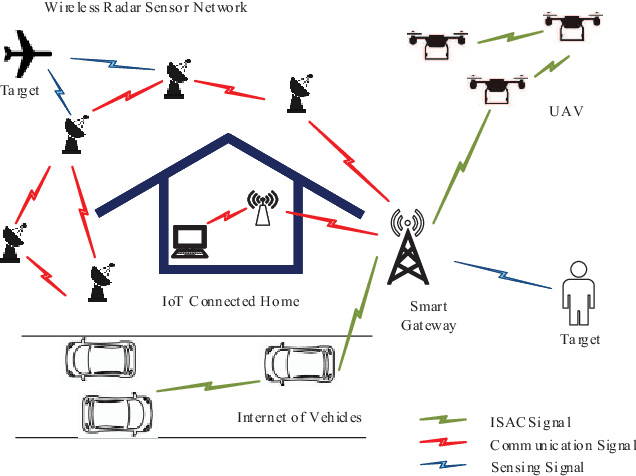
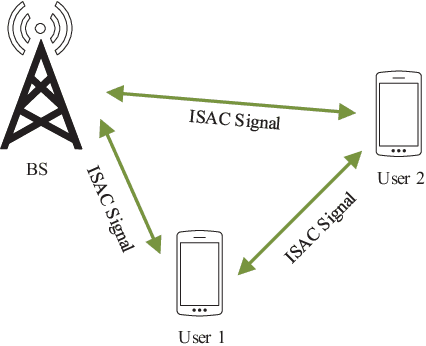
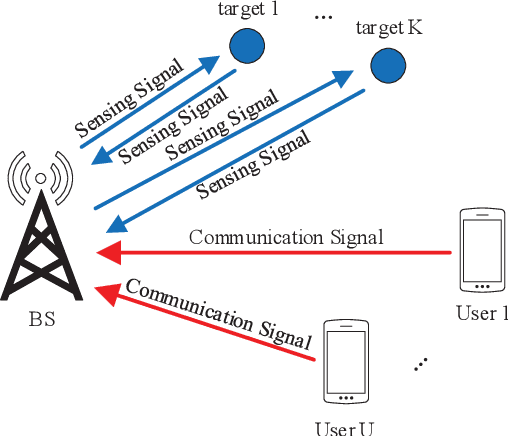
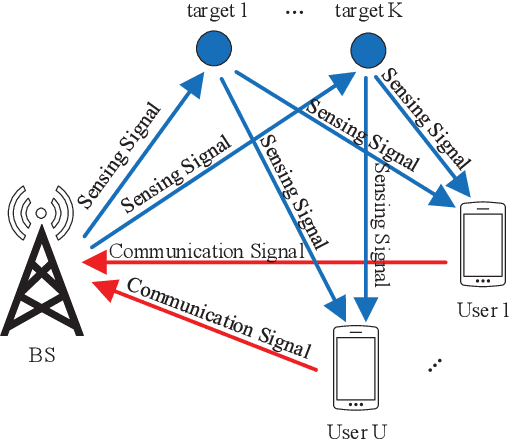
Abstract:The integrated sensing and communication (ISAC), in which the sensing and communication share the same frequency band and hardware, has emerged as a key technology in future wireless systems. Early works on ISAC have been focused on the design, analysis and optimization of practical ISAC technologies for various ISAC systems. While this line of works are necessary, it is equally important to study the fundamental limits of ISAC in order to understand the gap between the current state-of-the-art technologies and the performance limits, and provide useful insights and guidance for the development of better ISAC technologies that can approach the performance limits. In this paper, we aim to provide a comprehensive survey for the current research progress on the fundamental limits of ISAC. Particularly, we first propose a systematic classification method for both traditional radio sensing (such as radar sensing and wireless localization) and ISAC so that they can be naturally incorporated into a unified framework. Then we summarize the major performance metrics and bounds used in sensing, communications and ISAC, respectively. After that, we present the current research progresses on fundamental limits of each class of the traditional sensing and ISAC systems. Finally, the open problems and future research directions are discussed.
 Add to Chrome
Add to Chrome Add to Firefox
Add to Firefox Add to Edge
Add to Edge